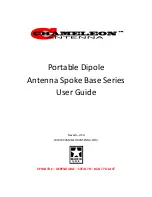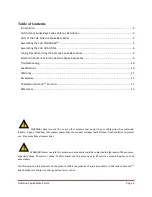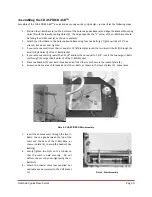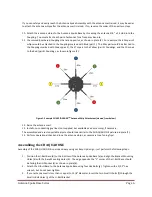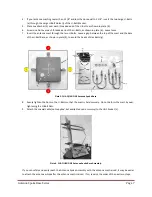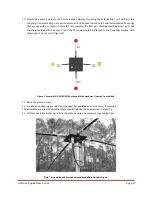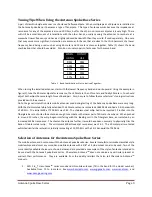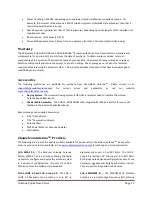
Antenna Spoke Base Series
Page 10
2.
Workman WHF__ series monoband HF mobile antennas (fill in the band for the model number). Available
from 75 to 6 meters. See
Troubleshooting
Most problems experienced when installing the Antenna Spoke Base are likely to be caused by mis-tuned
HamStick-style whips. Perform the following procedure to isolate the problem.
1.
Remove all but the lowest frequency pair of antennas.
2.
Connect a Standing Wave Ratio (SWR) Power Meter and check SWR.
3.
If the SWR is less than infinity (less than full deflection on the meter), it is likely this is a tuning problem.
Note:
during testing of the Antenna Spoke Base, a mis-tuned pair of antennas had an SWR of 16:1.
Go to step 9.
Continuity Troubleshooting.
4.
If SWR is close to infinity (close to full deflection on the meter), ensure the UHF Connector Plugs are securely
tightened. Recheck SWR.
5.
If the SWR is still close to infinity, inspect and check or replace the coaxial cable.
Most problems causing
extremely high SWR are caused by the coaxial cables and connectors.
Recheck SWR.
6.
If the SWR is still close to infinity, try another pair of antennas. Recheck SWR.
7.
If the SWR is still close to infinity, disconnect the coaxial cable from the Antenna Spoke Base. Use a Multi-
Meter to check for a short in the Antenna Spoke Base by placing one lead on the outside of the UHF Socket (c)
and the other lead in the center of the UHF Socket. It should have an infinite resistance. If it has any value
other than an infinite resistance reading
(within the accuracy of the meter),
replace the Antenna Spoke Base.
8.
Use a Multi-Meter to check for continuity in the Antenna Spoke Base by placing one lead in the center of the
UHF Socket and the other lead on any of the Couplings. Keep track of the Couplings you are testing. Four of
the Couplings, one from each pair, as shown in plate (2), should have zero resistance. The other four
Couplings (the ones on the opposite side), should have infinite resistance. Move the Multi-Meter lead from
the center of the UHF Socket to the outside of the UHF Socket and remeasure the four that had infinite
resistance. They should now have zero resistance. If any of the Couplings have unexpected values
(not close
to zero or infinity - within the accuracy of the meter)
, replace the Antenna Spoke Base.
Tuning Troubleshooting.
9.
HamStick-style antennas have a narrow bandwidth. Using low power, sweep across the band of the antenna
installed and see if it is resonant anywhere in the band. If the SWR is lowest below the desired operating
frequency, the antenna is too long. Shorten the antenna by collapsing the whips the same length on both
antennas. Lengthen the antenna if the frequency with the lowest SWR is above the desired operating
frequency.
Always follow the manufacturer’s instructions for tuning the antenna.
Note: it may be necessary
to use an antenna analyzer for this step.
10.
Re-check the SWR. If still too high on the desired operating frequency and lower below or above, repeat step
9. An SWR less than 2.0:1 can be considered acceptable. If the SWR is 2.0:1 or greater after tuning, one of the
pair of antennas for that frequency band may be defective. Replace the defective antenna and repeat step 9.
11.
Once the lowest frequency band pair of antennas has an acceptable SWR, you can install the next set and
repeat step 9 for the new frequency band until all sets of antennas have been installed and tuned.
12.
If still not operating correctly, contact Chameleon Antenna for technical support. Explain to them the steps
you have already taken to isolate the problem.
Specifications
•
Frequency Range: 3.5 to 54.0 MHz, depending upon the installed user-supplied antennas.
•
Number of Bands: CHA Spider ASB
TM
–
four bands. CHA QUAD ONE
–
two bands.

